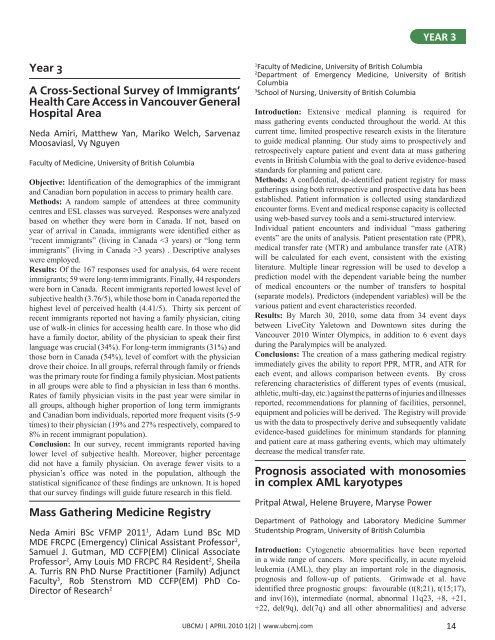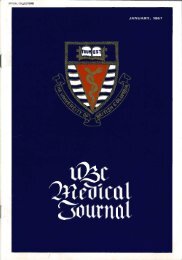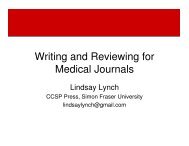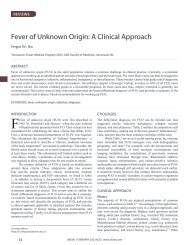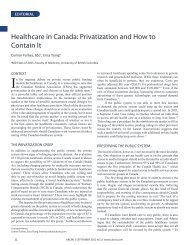Download full PDF - UBC Medical Journal
Download full PDF - UBC Medical Journal
Download full PDF - UBC Medical Journal
You also want an ePaper? Increase the reach of your titles
YUMPU automatically turns print PDFs into web optimized ePapers that Google loves.
YEAR 3<br />
Year 3<br />
A Cross-Sectional Survey of Immigrants’<br />
Health Care Access in Vancouver General<br />
Hospital Area<br />
Neda Amiri, Matthew Yan, Mariko Welch, Sarvenaz<br />
Moosaviasl, Vy Nguyen<br />
Faculty of Medicine, University of British Columbia<br />
Objective: Identification of the demographics of the immigrant<br />
and Canadian born population in access to primary health care.<br />
Methods: A random sample of attendees at three community<br />
centres and ESL classes was surveyed. Responses were analyzed<br />
based on whether they were born in Canada. If not, based on<br />
year of arrival in Canada, immigrants were identified either as<br />
“recent immigrants” (living in Canada 3 years) . Descriptive analyses<br />
were employed.<br />
Results: Of the 167 responses used for analysis, 64 were recent<br />
immigrants; 59 were long-term immigrants. Finally, 44 responders<br />
were born in Canada. Recent immigrants reported lowest level of<br />
subjective health (3.76/5), while those born in Canada reported the<br />
highest level of perceived health (4.41/5). Thirty six percent of<br />
recent immigrants reported not having a family physician, citing<br />
use of walk-in clinics for accessing health care. In those who did<br />
have a family doctor, ability of the physician to speak their first<br />
language was crucial (34%). For long-term immigrants (31%) and<br />
those born in Canada (54%), level of comfort with the physician<br />
drove their choice. In all groups, referral through family or friends<br />
was the primary route for finding a family physician. Most patients<br />
in all groups were able to find a physician in less than 6 months.<br />
Rates of family physician visits in the past year were similar in<br />
all groups, although higher proportion of long term immigrants<br />
and Canadian born individuals, reported more frequent visits (5-9<br />
times) to their physician (19% and 27% respectively, compared to<br />
8% in recent immigrant population).<br />
Conclusion: In our survey, recent immigrants reported having<br />
lower level of subjective health. Moreover, higher percentage<br />
did not have a family physician. On average fewer visits to a<br />
physician’s office was noted in the population, although the<br />
statistical significance of these findings are unknown. It is hoped<br />
that our survey findings will guide future research in this field.<br />
Mass Gathering Medicine Registry<br />
Neda Amiri BSc VFMP 2011 1 , Adam Lund BSc MD<br />
MDE FRCPC (Emergency) Clinical Assistant Professor 2 ,<br />
Samuel J. Gutman, MD CCFP(EM) Clinical Associate<br />
Professor 2 , Amy Louis MD FRCPC R4 Resident 2 , Sheila<br />
A. Turris RN PhD Nurse Practitioner (Family) Adjunct<br />
Faculty 3 , Rob Stenstrom MD CCFP(EM) PhD Co-<br />
Director of Research 2<br />
1<br />
Faculty of Medicine, University of British Columbia<br />
2<br />
Department of Emergency Medicine, University of British<br />
Columbia<br />
3<br />
School of Nursing, University of British Columbia<br />
Introduction: Extensive medical planning is required for<br />
mass gathering events conducted throughout the world. At this<br />
current time, limited prospective research exists in the literature<br />
to guide medical planning. Our study aims to prospectively and<br />
retrospectively capture patient and event data at mass gathering<br />
events in British Columbia with the goal to derive evidence-based<br />
standards for planning and patient care.<br />
Methods: A confidential, de-identified patient registry for mass<br />
gatherings using both retrospective and prospective data has been<br />
established. Patient information is collected using standardized<br />
encounter forms. Event and medical response capacity is collected<br />
using web-based survey tools and a semi-structured interview.<br />
Individual patient encounters and individual “mass gathering<br />
events” are the units of analysis. Patient presentation rate (PPR),<br />
medical transfer rate (MTR) and ambulance transfer rate (ATR)<br />
will be calculated for each event, consistent with the existing<br />
literature. Multiple linear regression will be used to develop a<br />
prediction model with the dependent variable being the number<br />
of medical encounters or the number of transfers to hospital<br />
(separate models). Predictors (independent variables) will be the<br />
various patient and event characteristics recorded.<br />
Results: By March 30, 2010, some data from 34 event days<br />
between LiveCity Yaletown and Downtown sites during the<br />
Vancouver 2010 Winter Olympics, in addition to 6 event days<br />
during the Paralympics will be analyzed.<br />
Conclusions: The creation of a mass gathering medical registry<br />
immediately gives the ability to report PPR, MTR, and ATR for<br />
each event, and allows comparison between events. By cross<br />
referencing characteristics of different types of events (musical,<br />
athletic, multi-day, etc.) against the patterns of injuries and illnesses<br />
reported, recommendations for planning of facilities, personnel,<br />
equipment and policies will be derived. The Registry will provide<br />
us with the data to prospectively derive and subsequently validate<br />
evidence-based guidelines for minimum standards for planning<br />
and patient care at mass gathering events, which may ultimately<br />
decrease the medical transfer rate.<br />
Prognosis associated with monosomies<br />
in complex AML karyotypes<br />
Pritpal Atwal, Helene Bruyere, Maryse Power<br />
Department of Pathology and Laboratory Medicine Summer<br />
Studentship Program, University of British Columbia<br />
Introduction: Cytogenetic abnormalities have been reported<br />
in a wide range of cancers. More specifically, in acute myeloid<br />
leukemia (AML), they play an important role in the diagnosis,<br />
prognosis and follow-up of patients. Grimwade et al. have<br />
identified three prognostic groups: favourable (t(8;21), t(15;17),<br />
and inv(16)), intermediate (normal, abnormal 11q23, +8, +21,<br />
+22, del(9q), del(7q) and all other abnormalities) and adverse<br />
<strong>UBC</strong>MJ | APRIL 2010 1(2) | www.ubcmj.com 14


